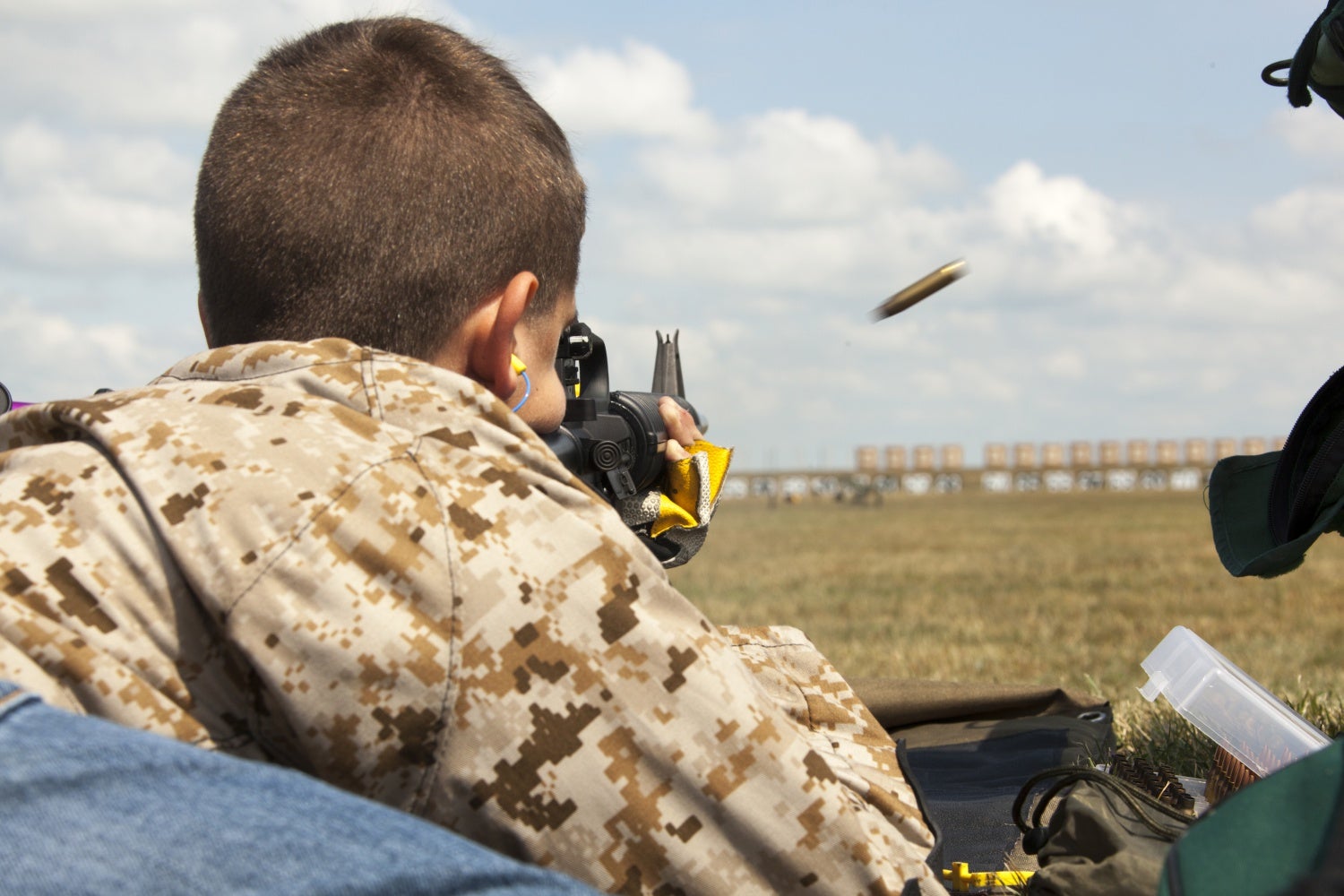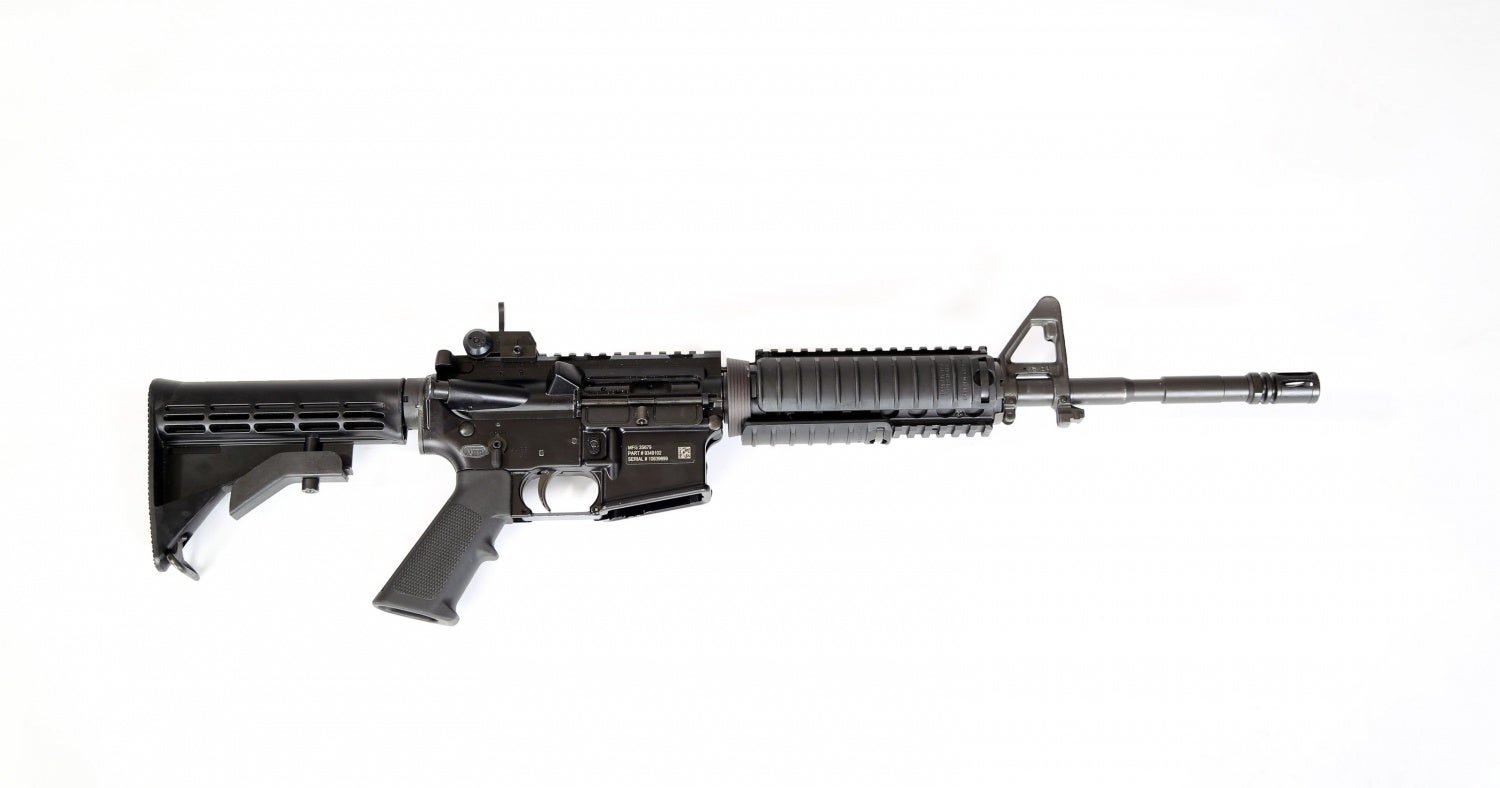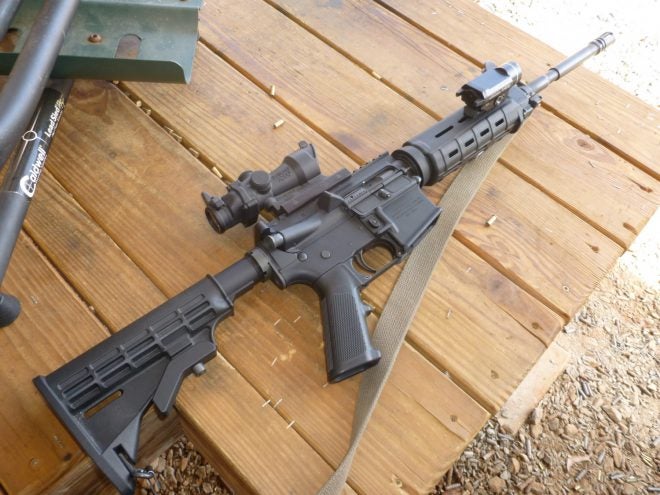It’s no good to discuss how firearms work without also giving the context surrounding the firearms themselves. With that said, let’s talk about the AR-15, its copycats, competitors, and relatives. Together these rifles share space under the loose umbrella of black rifles, a term which references the use of lighter and more durable black polymer gunstocks in place of traditional wood, something that became common from the 1960s onward in military firearms design. Today the term simply means any modern military rifle, or any rifle patterned after a modern military rifle, the two most common of these by far being the AR-15 and AK types. For the purposes of this article, we’ll focus on the AR-15, but much of what we’ll talk about will be applicable to any black rifle.

Other rifles, like this Bulgarian SLR-104FR, share many characteristics and their general appearance with the AR-15, despite having different origins and being mechanically distinct. Rifles in this class are often called “black rifles”, regardless of their exact type.
The AR-15 has its genesis in the 1940s, during World War II. At that time, it was discovered that not only had handheld, mobile fully automatic firepower become a key factor in modern infantry tactics, but also that the ranges at which infantry weapons were being used effectively were much shorter than previously assumed. The result of this was research beginning in the 1950s into smaller, less powerful types of ammunition, called intermediate calibers, which would by virtue of their low power be controllable when firing fully automatically, but which would also still have enough range for the reduced distance engagements expected in the future. At the same time, a company called Armalite began experimenting with new materials previously not commonly used in firearms design, like plastics, carbon fiber, and aluminum. The company was asked by the US government to develop a new, smaller weapon with select-fire capability, chambered for a .22 caliber intermediate cartridge. The weapon the company produced by 1957 was called the “AR-15”, “AR” standing for “ARmalite” and “-15” standing for the fifteenth design produced by the company. This early rifle was extremely lightweight, weighing less than 6 pounds, and extremely controllable on fully automatic, while also being accurate in semi-automatic fire. The US Army, however, had different ideas, and it took a unilateral action from then-Secretary of Defense Robert McNamara to force the Army to adopt the rifle, which they did in 1963 as the “M16”, an act that remains controversial to this day. The M16 was famously beset by teething troubles that resulted in jammed weapons and soldiers unable to fight back against their Communist opponents, which marked the weapon with a reputation it has only recently begun to shake.
Despite its poor start, the AR-15’s virtues and lightweight ammunition set off a firestorm of development. Virtually every national military, including those in the Communist blocs, began development of similar weapons. Even the Russians poached the .22 caliber intermediate cartridge concept, which they implemented in a variant of their older, and world-famous AK design, and that AK-74 rifle is today still the standard arm of the Russian Federation. The AR-15 began to make waves on the civilian market as well, as Colt – who purchased the design from Armalite in 1959 – marketed semi-automatic only AR-15s to the American public beginning in 1964. These rifles, and similar designs from other companies, continued to sell steadily, although more traditional rifles still remained dominant. For those unfamiliar, the difference between semiautomatic, fully automatic, and select fire weapons is explained in the first minute and a half of the video embedded below:
In 1994, the Federal Assault Weapons Ban was signed into law as part of the Violent Crime Control and Law Enforcement Act, which seriously restricted the features that rifles like the AR-15 could possess if they were to be sold legally on the civilian market. The new weapons, compliant with the Act, not only raised the resale value of older “full feature” weapons which were grandfathered in under the law, but it also raised interest in these rifles considerably. Ten years later, in 2004, the FAWB provision expired, just before the Presidential election in that year. Concerns that the ban would be re-enacted if Democratic Party candidate John Kerry took office ignited the American public to buy black rifles as never before, and every election season since then has set off larger and larger firestorms of gun purchases.
From 2004-2010, the AR-15 went from being a niche weapon to the single most popular centerfire rifle in the United States. While political fervor has catapulted the rifle to the top, its superb merits have solidified its position there. It is a lightweight, reliable design that is capable of exceptional accuracy for its class, and it has introduced the American public to an unprecedented degree of modularity in a firearm. Due to its design, the AR-15 can be configured in countless ways, customized easily by any unskilled hobbyist to the configuration that suits them best. AR-15 parts can be bought cheaply, and assembled into a complete rifle in a suburban garage with only a few tools. Homebrewers can even make their own receivers from kits not legally classified as firearms, using nothing more exotic than a drill press. The AR-15’s accuracy and light weight makes it an excellent platform for hunting, and its modularity means that there is no shortage of different caliber options suitable for a wide variety of game. As a result, today the AR-15 is one of the most popular hunting rifles in the country. AR-15s are an extemely popular choice for shooting competitions as well, the basic pattern serving equally well as both a “run-and-gun” weapon for practical shooting competitions like 3-Gun, and as a precision platform capable of great accuracy out to 600 yards in long range competitions like NRA High Power.

Original caption: “Nicholaus Paylor, age 13 from Hester, La., fires a practice round from the 300-yard line aboard Camp Perry, Ohio, July 28, 2012 in preparation for the Excellence in Competition matches. Youths between the ages of 12 and 20 take part in the three day United States Marine Corps Juniors Clinic to enhance their marksmanship skills.” Image source: commons.wikimedia.org
The civilian AR-15 remains controversial, however, despite the fact that these rifles do not possess the fully automatic capability of their military ancestors. Their nontraditional looks and military origins have made them a high profile political football in the US and elsewhere, despite the fact that most other civilian firearms are adapted military weapons, as well.
On the military side, the select-fire AR-15 pattern has secured itself as one of the most well respected designs in the world, yet it too has remained controversial. The bungled initial issuance of the early M16 left a black mark on the rifle that it has only begun to escape, and this was magnified by an industry incentive to replace the design. In the early 1990s, Colt introduced the M4 Carbine, a shortened variant of the M16A2 which at the time equipped US military forces. The US Army adopted the M4 Carbine in 1994 to replace the M16A2 in some roles, and in doing so gave Colt a sole-source contract for the carbine that lasted for 15 years, until 2009. Since other firms had no possibility of winning a military contract so long as Colt retained the rights and technical data package (TDP) to the M4, they instead attempted several times to court the Army to replace it with new rifles of their own design. After 2009, companies could compete against Colt to produce the M4 itself. In 2011, the US Army was ordered by Congress to conduct a competition – called “Individual Carbine” – to evaluate possible replacements for the M4, a program which concluded after no replacement was judged better enough to warrant adoption. The controversy over the M4 and the results of the Individual Carbine Competition (ICC) continues to this day.

The US Army’s current rifle is the M4A1 Carbine, which is capable of both semiautomatic and fully automatic fire, unlike civilian variants of the AR-15. Image source: ArmyTimes.com
I have written this article from a position of great familiarity with the rifle. My personal AR-15 is a Colt 6920, a civilian-legal 16″ barreled variant of the military M4 Carbine, lacking select fire and thus – like all non-NFA civilian-legal rifles of this type – capable of firing only one shot per pull of the trigger. I have fired thousands of rounds through my Colt myself, and I have taught many others to shoot with it, as well. It is an easy, instinctive weapon to shoot well, with convenient controls and no major flaws that prevent one from using it to the best of their abilities. Recoil is mild, although not nonexistent, the weapon is lightweight, and can be shot for several hours without fatigue. With the four power optic I have mounted on it, it is capable both of shooting quickly at short distances, and accurately at long distances. Reliable and safe ammunition is plentiful and very cheap. It is therefore a near-perfect weapon for civilian shooters who want to be able to participate in many different shooting disciplines and activities (like hunting) without needing to purchase multiple different specialized rifles. For all these reasons, and more, Black rifles – especially the AR-15 – have rightfully become the weapons of choice for the modern American marksmanship tradition.

Original caption: “Nathan Baldwin, 14, concentrates on his target during live-fire training Aug 1, 2009. He is being instructed on the M-16A2 by Spc. Evan Hess, U.S. Army Marksmanship Unit. Soldiers from the USAMU conducted the 2009 Small Arms Firing School, teaching novice shooters the efficient application of the fundamentals of marksmanship.” Image source: commons.wikimedia.org
 Your Privacy Choices
Your Privacy Choices
